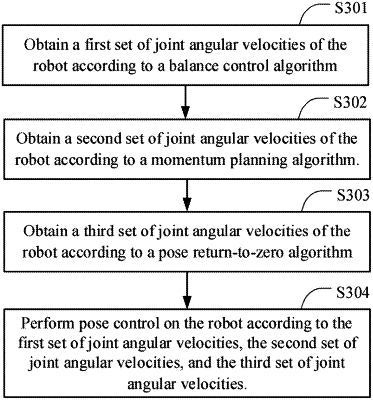| CPC B25J 9/1653 (2013.01) [B25J 9/1607 (2013.01); B25J 9/1664 (2013.01); B25J 13/088 (2013.01)] | 20 Claims |

|
1. A computer-implemented pose control method for a robot, comprising:
estimating a first set of joint angular velocities of all joints of the robot according to a balance control algorithm;
estimating a second set of joint angular velocities of all joints of the robot according to a momentum planning algorithm;
estimating a third set of joint angular velocities of all joints of the robot according to a pose return-to-zero algorithm; and
performing pose control on the robot according to the first set of joint angular velocities, the second set of joint angular velocities, and the third set of joint angular velocities;
wherein estimating the second set of joint angular velocities of all joints of the robot according to the momentum planning algorithm comprises:
obtaining actual joint angular velocities of the robot;
calculating an actual momentum of the robot according to the actual joint angular velocities;
constructing a counter-rotational momentum corresponding to the actual momentum; and
calculating the second set of joint angular velocities according to the counter-rotational momentum; and
wherein the actual momentum of the robot is calculated according to the following equation: mfeedback=Aωfeedback, where A represents a predefined mapping matrix, ωfeedback represents the actual angular velocities, and mfeedback represents the actual momentum of the robot.
|